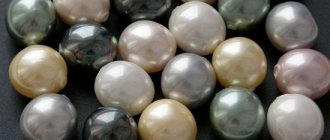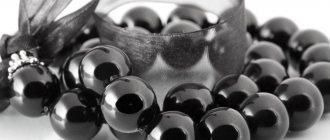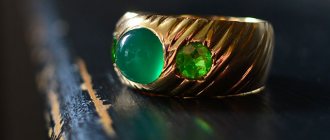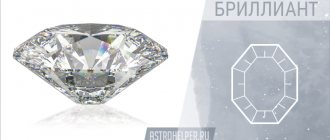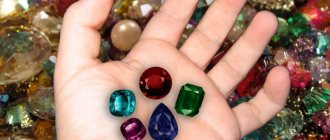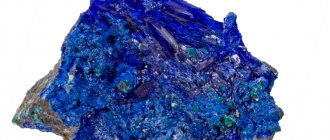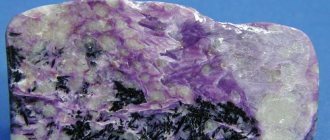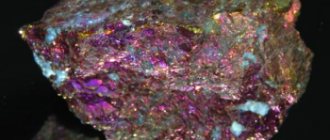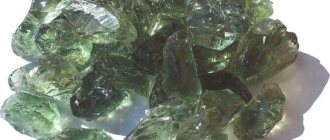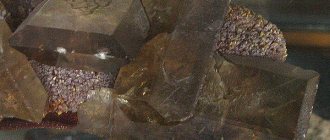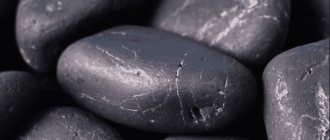| Category | Sulfides (minerals) |
| Title in English | Galena |
| Formula | PbS |
| Group | Lead group |
| Color | Grey |
| Stroke color | Grey |
| Shine | Metal |
| Transparency | Opaque |
| singonia | Cubic |
| Hardness | 2,5 — 2,75 |
| Cleavage | Perfect |
| Density, g/cm³ | 7,4 — 7,6 |
| Kink | Conchoidal |
| origin of name | The Latin word Galena, which was used to name the mineral, translates as “lead ore.” Also, the second version of the translation says that galena means “lead sheen” or scale. By the way, the ancient Roman writer Pliny the Elder mentioned a mineral called galena. |
| Morphology | Galena has cubic crystals as well as cuboctahedra. Octahedrons have the lowest frequency. Crystals can have a tabular appearance. The stone forms reticulate masses and skeletal crystals. |
A dark gray mineral with a metallic luster of the sulfide class is called galena. It often contains silver, copper and cadmium as impurities. And pyrite, quartz, calcite and sphalerite are its companion minerals in the deposits. Almost 90% of galena consists of lead sulfide. It is opaque and very fragile. High humidity and exposure to the sun have a negative effect on galena, and it loses its extraordinary leaden luster. Galena has been known to mankind for a very long time; the mineral was named “galena” in Latin, which translates as “lead scale” and indicates its chemical composition. Galenas became a source of lead from the ancient Romans.
origin of name
The Latin name for the mineral is galena - lead ore - mentioned by Pliny. The name galena was given by Kobel (1838).
Synonyms of the mineral galena:
Lead shine (Glocker, 1847). Apparently, mixtures of galena with other minerals include steinmannite (Ziepe, 1833), targionite (Bahey, 1852), cuproplumbite (Breithaupt, 1844), johnstonite (Haidinger, 1845), alyzonite (Field, 1859), furietite (Maine, 1860). ), guascolite (Dana, 1868), plumbocuprite and nolascite (Adam, 1869), paracobellite (Shrauf, 1871), kilmakuite (Tischborn, 1885). Fine-grained masses of galena with a matte sheen are called svinchak. Quirogite from the Sierra Almagrera (Spain), described by Navaro (1895) as a tetragonal mineral, according to X-ray data turned out to be galena of a special, distorted appearance. Castillite turned out to be a mixture of galena with Zn and Ag sulfides (Ramelsberg, 1866; Kalb, 1923). Richmondite (Skey, 1877) is a mixture of galena, fahlore, sphalerite and others. Plumbomangite (Köchlin, 1911) is a mixture of galena with various ore minerals.
An intergrowth of crystals with forms of uneven development on the faces and edges of a cube. Primorye Dalnegorskoye field
Products made from nugget
Jewelry, like the stone itself, can serve as a talisman, amulet or amulet. Rings with a mineral on the ring or middle finger give the wearer determination, perseverance and the desire to achieve their goals. You will have the ability to make the right decisions based on your own opinion, regardless of the public. Wearing such jewelry on other fingers will betray excessive legibility, meekness and prudence in the character of the wearer.
Pendants or necklaces with galena will allow you to make the right decisions in important matters. When doubts or self-doubt arise, earrings with a mineral will help. Men can wear one earring.
Galena amulets and talismans will give the owner popularity, respect from society, happiness, and well-being. The wearer will always be in mental balance and harmony with himself. Do not forget about the toxicity of the mineral. Therefore, it is not recommended to abuse jewelry made from it.
Chemical composition of galena
Theoretical chemical composition of the mineral: Pb - 86.60; S - 13.40. S is isomorphically replaced by Se; There is a continuous isomorphic series galena (PbS) - clausthalite (PbSe), various representatives of which are found in nature. Galena often contains an admixture of Ag, usually up to 0.1%, less often 0.5-1% and higher, which is partly due to the presence of inclusions of silver sulfides, partly due to the presence of AgBiS2 in the solid solution. Analyzes also show the presence of Zn, Cd, Sb, Bi, Cu, Sn, In, Tl, Au, Pt and others (usually no more than tenths of a percent); in most cases this is due to the presence of impurities of other minerals: sphalerite, boulangerite, chalcopyrite and others. Lead in galenas is a mixture of isotopes Pb2O4, Pb2O6, Pb2O7, and Pb2O8. The last three isotopes continuously accumulate in the earth's crust due to the radioactive decay of U and Th. The lead isotopic composition of galena can be used to determine absolute age.
Galena
Therapeutic effect
The healing effects of the mineral are controversial.
In ancient times the following properties were attributed to it:
- Strengthen the body as a whole. It was even recommended to children and pregnant women.
- Eliminate colic, spasms, gastrointestinal problems.
- The powder served as a “deodorant.”
The main property of galena was considered to be its ability to rejuvenate the body.
Modern medicine considers the mineral dangerous to health. This is almost pure lead - a toxic substance that is difficult to remove from the body.
However, doctors insist: homeopathic doses of the mineral are harmless. Such drugs are recommended for depression, aggression, and other mental deviations.
Varieties
Selenium galena from Rudny Altai, containing a small amount of Se, and intermediate members of the galena-clausthalite series from Colorado (USA), in which the PbSe content varies from 6.5 to 93.7 mol. %. Altai selenium galena has a density of 7.2 - 7.5. The cleavage planes have a dull sheen, and tarnish is often from bronze-yellow to bluish-black. Unlike ordinary galena, it is less resistant to weathering. It is found in the Zyryanovsky and Chudak deposits in the form of veinlets among copper ores in association with chalcopyrite, pyrite, and tetrahedrite. Galena-claustalites of the Colorado Plateau (USA) form inclusions in sulfide veinlets of uranium-vanadium deposits.
Svinchak is a dense matte galena.
Which stones go with?
Galena is a stone of the earth element, symbolizing metal. His main friends are sphalerite and pyrrhotite, tin and pyrite, as well as all gems that have a metallic luster.
Among its fellow elements, the proud galena dislikes only malachite. Both of these gems prefer to be in the spotlight and begin to pull it towards themselves, thereby robbing the owner of his strength instead of sharing it with him. The same thing will happen if you place galena and emerald or diamond or ruby next to each other. Lead gem gets along well with other stones.
Crystallographic characteristics
Cubic crystal system, hexaoctahedral class
Crystal structure Cubic face-centered lattice with four molecules per unit cell.
The main forms: cubic, cuboctahedral, octahedral, rarely trioctahedral and hexoctahedral. Cubic skeletal crystals are known. There are often unevenly developed crystals, elongated, columnar, elongated, and also tabular along the edge of a cube or octahedron.
Form of being in nature
The appearance of crystals.
Galena, pyrite. Druse of crystals
Crystals - from small to large (several centimeters in size) - are rarely ingrown; in most cases they grow and form drusen and groups.
Twins of the mineral at (111) are common; twins of intergrowth and germination are most common, often tabular, sometimes polysynthetic; twin growths are observed along (441), along (311) and (331), causing oblique streaking on the faces of the cube; Twin growths are indicated according to (520) or (730) in galena from Ratibořice (Czech Republic), secondary deformation twins are indicated according to (322), (221), (771) and (411). Forms oriented intergrowths with cotunnite, phosgenite and anglesite, pyrite, chalcopyrite, bournonite, fahlores, pyrrhotite, arsenopyrite, pyromorphite.
Aggregates.
The most common are grains and granular aggregates, less often - dense masses of druses, sometimes - sinter aggregates; Crystals and crystalline skeletal formations are relatively common.
Average mineral price
Galena is an inexpensive mineral. The price of a medium-sized stone is 300–800 rubles.
The cost of a mineral also depends on its appearance. Beautiful multi-colored crystals that include other rocks will cost more.
Galena is the most important source of lead mining. Impurities of other minerals and precious metals, including gold, platinum and silver, are also isolated from it. The stone does not have healing properties, but it is credited with a strong magical influence.
Leave a review, your opinion is important to us, have you used galena? Share information on social media. networks. All the best.
Physical properties Optical
- The color is lead-gray, somewhat lighter in fine-grained aggregates; galena with octahedral separation containing Bi is somewhat darker; sometimes a mottled discoloration is observed.
- The streak is greyish-black.
- The luster is metallic, strong on the cleavage planes; galena with octahedral separation has a slightly duller luster; dense varieties are often matte.
Perfect cleavage in three directions
Mechanical
- Hardness 2-3.
- Density 7.4—7.6
- The cleavage is perfect (along the cube), in three directions parallel to the faces of the cube (100).
Sometimes separation at (111) is observed, characteristic of galena with a high bismuth content, which is explained by inclusions of bismuthin located partly along (111) of galena (the result of the decomposition of a solid solution of bismuth sulfide in galena) or the existence of a solid solution of AgBiS2 in galena. When heated, the octahedral separation disappears and is replaced by cube cleavage.
The fracture of the mineral in dense masses is flat-shell-shaped, uneven; in galenas with octahedral separation, the fracture is finely stepped.
How to identify a fake
Natural galena looks almost like tin, pyrite and similar minerals.
It is easy to distinguish by several characteristics:
- The metallic color and shine are well expressed.
- Doesn't leave a mark on paper. On ceramics it is gray-black.
- Upon impact, it crumbles into crystal-like cubes.
Jewelers or decorators are not interested in galena. Being able to distinguish an original from an imitation is important for collectors of mineralogical collections and those who buy stones for magical or medicinal purposes.
Galena. Chemical properties
The mineral dissolves in HNO3, releasing S and lead sulfate; When HCl is added to a nitric acid solution, a white precipitate of PbCl2 precipitates, soluble in hot water. Galena also decomposes with hot or strong HCl. Solutions of NaCl and CaCl2 have an effect on the mineral, especially at elevated temperatures and pressures. In polished sections, HNO3 quickly turns black, HCl turns slightly brown, and FeCl3 produces an iridescent tarnish; not etched by KCN, KOH, HgCl2, (NH4)2S. The structural features of the aggregates are revealed by etching with HCl (1: 1 or 1: 5). Microchemically, Pb is determined with KCN on a thin section, S - by imprinting on silver bromide paper. Film reaction: with a saturated solution of J in 5% KJ, when boiled, the mineral turns yellow-green.
Other properties
The mineral conducts electricity. On the octahedral face of the mineral, the electrical conductivity is higher than on the cube face. Electrical conductivity increases with increasing temperature, but above 300° it drops sharply (Niggli). Detects either positive or negative photoelectric effect. Galenas with a positive photoelectric effect do not have detector properties; Galenas, which give a negative photoelectric effect, are good detectors. Diamagnetic
Behavior of a mineral when heated: Melting point. 1112°. At high temperatures (above 350°), PbS forms solid solutions with AgBiS2. Ramdor (1955) explains this for the high Ag content in galenas that do not contain microscopically detectable Ag-bearing minerals. It is characteristic that in these cases a noticeable, often equivalent amount of Bi is always present. Thus, in galenas formed at average and elevated temperatures, it can be assumed that matildite is present in a solid solution.
The stone is easily chipped in steps along three mutually perpendicular planes.
Obtaining galena
It is easily obtained in various ways (Dölter, 1925), for example, by the action of H2S on acidified HNO3 solutions of Pb salts (amorphous and crystalline PbS); during the interaction of chloride compounds Pb with dry H2S in a heated tube; during the decomposition of lead sulfate in an atmosphere of H2 or CO; when lead sulfate interacts with rotting organic matter in water, when pyrite or marcasite is heated with a PbCl2 solution.
Crystals of galena and sphalerite with calcite
Diagnostic signs
The mineral is easily identified by its color, luster, characteristic cleavage in the cube, low hardness and high density. In fine-crystalline masses it differs from similar antimonous and arsenic compounds in density, behavior under the blowpipe and chemical reactions. In polished sections, the possibility of mixing galena with other common white isotropic minerals is almost excluded, since it clearly differs from them in the main characteristics: reflectivity, color, hardness, and especially in chipping triangles. In small grains it can be mixed with altaite (PbTe), clausthalite (PbSe), but the first is significantly, and the second is only somewhat lighter and much softer.
Satellites. Its most typical companion among the hypogene minerals in various deposits is sphalerite - these are the so-called polymetallic ores. ; often accompanied by pyrite and chalcopyrite. The vein minerals in most hydrothermal deposits are quartz, barite, fluorite, and calcite.
How to wear
Products with galena are not universal:
- The mineral insert of a pendant, ring, ring is an appropriate detail in a youth, men's wardrobe.
- Fans of subcultures love the stone.
- For a lady, a piece of jewelry with a miniature insert is suitable - but only for informal occasions.
If the mineral is used as a magical or healing artifact, it is recommended to wear it constantly or place it as an interior item in the office, on the dressing table, or on the bedside table.
And communicate with him more often: ask for advice, thank him for his help. Otherwise the stone will be offended.
Origin and location
Galena is one of the most common sulfide minerals of hydrothermal deposits, formed at various temperatures and in various geological settings. Medium- and low-temperature hydrothermal deposits are of greatest industrial importance. In the form of small rare grains, the mineral is found in pegmatites of granitic and alkaline magma, as a rare mineral - in igneous rocks and volcanic secretions. Supergene galena is found in some sedimentary formations. Sometimes the mineral forms almost monomineral ores (as, for example, in the Zavodinskoye deposit in Rudny Altai), but is usually accompanied by other sulfides.
Areas of application
Galena on quartz
Galena is the main source of lead.
The main area of application is the extraction of galena itself and various impurities (zinc, silver, native gold and others) from ore, without which it is extremely rare. In industry, lead sulfide is used:
- In the manufacture of ceramics and battery plates, water pipes and coins.
- As a material for various devices operating on semiconductors and photodetectors.
Place of Birth
In deposits among skarns in contact zones of granitoids and sedimentary rocks (mainly limestones), galena forms impregnations and granular aggregates, sometimes contained in significant quantities, accompanied by skarn minerals, sphalerite, chalcopyrite, pyrrhotite, etc. Examples: Altyn-Topkan in the Karamazar Mountains (Tajikistan ), Tetyukhe (Primorsky Territory), Kyzyl-Espe, Aksoran and Akchagyl (Northern Balkhash region, Kazakhstan), Savinskoye and other deposits of the Chita region, Darwin (California, USA), Schwarzenberg (Saxony, Germany) and others. In lead-zinc ores that form deposits and veins, galena, in close association with sphalerite, is accompanied by pyrite, chalcopyrite, often arsenopyrite, as well as fahl ores, pyrargyrite, stephanite, bournonite, boulangerite and other complex sulfides containing Ag, Pb, Cu . Occasionally it is also accompanied by Ni sulfides and arsenides.
Typical hydrothermal, predominantly medium-temperature deposits are: lead-zinc deposits of the Rudny Altai (Kazakhstan and Altai Territory) - Ridderskoye, Zyryanovskoye, Zmeinogorskoye and others; Sadonskoe vein deposit (North Ossetia Russia); deposits of the Mekhmaninsky ore field (Azerbaijan); some deposits in the central part of Kazakhstan (Berkara, Maykain, Aleksandrovskoye, Kurgasyn, Azhim); Achisay, Mirgalimsay deposits; in the Karatau mountains (Kazakhstan); in the Chita region—fields of the Nerchinsky district (Troitskoye, Smirnovskoye, Kadainskoye); vein deposits of Pribram (Czech Republic), Freiberg and Clausthal (Germany), Coeur d'Allen in the state. Idaho; Leadville in Colorado (USA), Sullivan (Canada), Santa Eulalia (Mexico), Broken Hill and Mount Isa (Australia), Bodwin (Burma) and many others.
Galena, chalcopyrite. Crystal intergrowth
Relatively low-temperature deposits include the Bleiberg deposit (Austria), some deposits in Silesia (Poland), Raible (Northern Italy), and deposits of the “lead belt” of Missouri (USA).
In varying quantities, galena is also found in essentially copper deposits (in Russia - Dzhezkazgan, some pyrite deposits of the Urals), in deposits of the sulfide-cassiterite formation (Yakutia, Primorsky Krai), in iron ore deposits (Bakalskoye deposit, Chelyabinsk region), in gold ore deposits quartz veins (Berezovskoye deposit, Sverdlovsk region), in tungsten and molybdenum deposits (North Kounradskoye, East Kounradskoye, Karaobinskoye deposits in Kazakhstan).
Supergene galena in sedimentary rocks occurs as a result of reduction by organic substances from lead sulfate or from the action of hydrogen sulfide on solutions of lead salts. Forms crusts and deposits on pyrite and marcasite nodules, dissemination and thin films in coals (Borovichi district, Novgorod region). It is found in limestones of various ages, in paragenesis with pyrite and marcasite, in the form of grains and crystals. In the Triassic deposits of Mount B. Bogdo (Astrakhan region), galena was found as an interlayer in limestone. Occasionally observed in rocks of various Cambro-Silurian and Devonian horizons near St. Petersburg. In cuprous sandstones and sandy limestones of Cambrian age, galena is observed in the form of syngenetic dissemination (upper reaches of the Lena, Irkutsk region). In the ore-bearing variegated Triassic sandstones of the Kemern-Mechernich region (Germany), galena, together with cerussite, chalcopyrite and copper carbonates in the form of nodules and scattered dissemination in the sandstone, is confined to a specific layer.
Galena is relatively common in phosphorite nodules of Podolia (Ukraine); it forms regular cubic crystals or fills irregular cavities inside the nodules, and is also located in their outer parts along the rays of the phosphate substance.
As a modern new formation, galena is noted in old mines: together with sphalerite in the form of deposits on iron chains in the mines of Upper Silesia (Poland), on abandoned tools - in crystals up to 12 mm in size in Missouri (USA).
Galena pseudomorphs are known from cerussite, anglesite, pyromorphite, chalcocite, bournonite, fahlores and wood. The typomorphic properties of galena from hydrothermal deposits are to some extent the appearance of the crystals and the content of impurities. Crystals of high-temperature hydrothermal galenas are often cubic in appearance, while those of lower temperatures are often octahedral in shape; High-temperature galenas are often bismuth-bearing, while lower-temperature galenas usually contain Ag and Sb.
Galena, chalcopyrite, quartz
Mining locations
There are many deposits of galena, they are found on all continents:
- America – Canada, Mexico, Chile, Peru;
- Europe – Great Britain, Austria, Romania, Czech Republic, Poland;
- Asia – Kazakhstan;
- Australia.
Russian places of galena mining are Altai, Primorye, Transbaikalia, and the Caucasus.
The United States produces the most galena ore on the planet, and Italy's mines have been in operation for two thousand years.
In deposits, compounds of the mineral with sphalerite are common. Such ores are called polymetallic. This is the main source of non-ferrous metals.
Physical research methods
Differential thermal analysis
Main lines on radiographs:
Ancient methods. Under a blowpipe on coal it cracks and shatters into pieces, but melts quietly in a fine powder. The coal near the sample is covered with a yellow coating of PbO with a bluish border (PbCO3). (Se - containing varieties form a reddish-brown coating on the coal near the sample with a narrow dark border; a characteristic, albeit weak, odor due to Se is detected). With soda on coal it produces a beetle of Pb, which after prolonged blowing either completely disappears or, if Ag is present, leaves a small beetle of Ag. Releases SO2 in an open tube
Crystal optical properties in thin preparations (sections)
Refractive indices 4.015 (C), 3.912 (D), 3.796 (F) (Winchel). In reflected light it is white and serves as a standard for white color. Reflectivity (in%): for green rays 43.5, for orange - 37.5, for red - 35; according to Folinsbee, measured using a photocell - 42.4. Isotropic. Sometimes it is anomalously anisotropic as a result of pressure or due to the presence of an isomorphic impurity α-AgBiS2. Galena is polished well in fine-grained aggregates, worse in coarse-grained ones. A characteristic diagnostic feature is the presence in polished sections of chipping triangles, identically oriented within single-crystal grains; the reason for their formation is perfect cleavage along the cube. Etching or weathering sometimes reveals a fine zonal structure, especially in low-temperature galenas.
